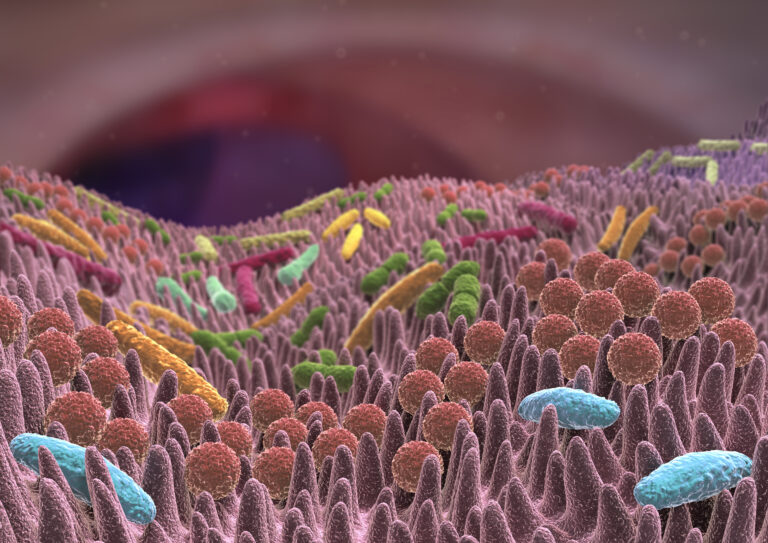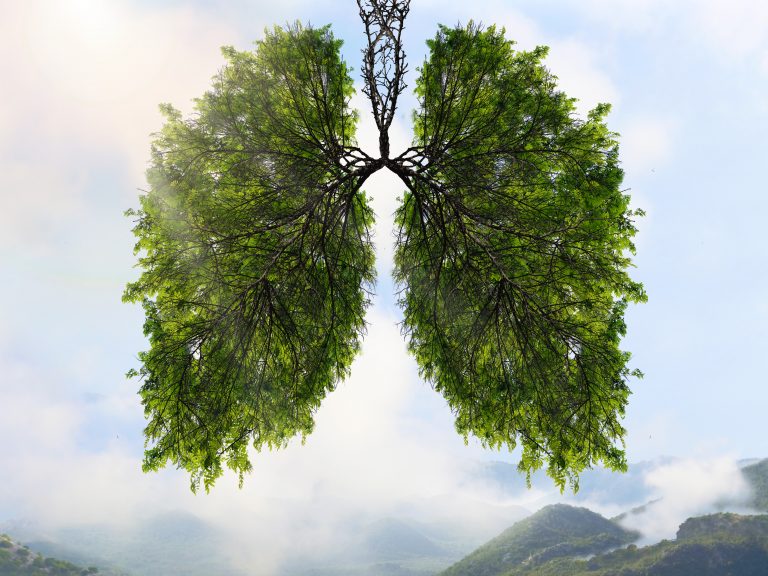
Naringenin und Covid-19
Das Flavanon Naringenin hat positive Wirkungen auf die Lunge und wurde schon als Mittel gegen Covid-19 getestet.
Neueste Studien analysieren die wechselseitigen Interaktionen der Pflanzenstoffe mit dem Mikrobiom. Die Flavanone selbst haben proliferierende und inhibierende Wirkungen auf einzelne Arten. Sie werden von bestimmten Mikroorganismen aufgenommen und in zahlreiche kleinere Phenolverbindungen gespalten, die auch wiederum Bakterienarten im Wachstum beeinflussen können [1],[2]. Zu den vorteilhaften Arten, die zum Wachstum angeregt werden, gehören die Akkermansia spp. und Faecalibacteria spp. sowie die kommensalen Arten (z.B. Bifidobacterium spp., Enterococcus spp., Clostridium spp.) [3],[4].Gleichzeitig wird das Firmicutes/ Bacteriodetes Verhältnis gesenkt [5], was sich gewichtsreduzierend und förderlich auf die Darmbarriere auswirkt. Potenziell pathogenen Keime (E. coli, Staphylococcus aureus, Salmonella typhimurium) [6] werden inhibiert.
As microbial degradation products of the flavanones (metabolites) e.g. Ferulic acid, isoferulic acid, dihydroferulic acid, dihydrocaffeeic acid, hydrozenmic acid or phloroeic acid are generated. These compounds have a positive effect on the barrier function of the intestine and reduce intestinal inflammatory reactions. Consumption over 12 weeks, naringenin lowers the calprotectin leveli n the stool. This is a biomarker that indicates intestinal inflammation [7]. The microbiome therefore provides practically an entire pharmacy for its carrier derived from the flavanons (in case they reach it). Metabolites differ in structure and abundande depending on the individual and intestinal activity [8]. Chen et al. identified 3- (4 ́-hydroxyphenyl)propionic acid (HPPS) as a degradation product of naringenin, which has various health-promoting properties [9]. Among other things, it even effectively prevents influenza infection [10]. Naringenin stimulates both the growth of the commensal species and their activity. This includes the production of short-chain fatty acids (SCFA), which further increases the pharmacy in the gut [11]. Stevens et al. have shown that Enterobacteriaceae (Proteobacteria) are inhibited, which are increasingly formed in old age. For example, this is just one of many reasons why microbiome-active naringenin can be used to protect against age-related diseases. El Nagger et al. made naringenin directly accessible to the gut microbiome for the first time in 2020 and were thus able to use the anti-inflammatory effect of flavanone to achieve maximum cell protection. El Nagger et al. were thus able to prevent induced ulcerative colitis in rabbits [12]. Inflammatory markers such as TNFα decreased and the intestinal mucus layer remained intact. Naringenin is able to improve the mucus layer [13] and intestinal barrier function [14]. Especially if these are accompanied by inflammatory reactions [15]. A sufficiently thick mucus layer together with an intact epithelial cell layer determines the functionality of the intestinal barrier [16]. The citrusflavanones stimulate the intestinal Lactobacillus spp., Akkermansia spp. and Ruminococcus spp. to grow [17]. In particular, the occurrence of the Akkermansia species is associated with intestinal health and a functioning intestinal barrier function [18] [19].
[1] Cueva C.et al. Antimicrobial activity of phenolic acids against commensal, probiotic and pathogenic bacteria. Res. Microbiol. (2010), 161:372–382. doi: 10.1016/j.resmic.2010.04.006.
[2] Kabir F. et al. Antimicrobial Effects of Chlorogenic Acid and Related Compounds. J. Korean Soc. Appl. Biol. Chem. (2014), 57:359–365. doi: 10.1007/s13765-014-4056-6
[3] Gwiazdowska D. et al. The impact of polyphenols on Bifidobacterium growth. Acta Biochim. Pol. (2015), 62: 895–901. doi: 10.18388/abp.2015_1154.
[4] Duque A.L.R.F. et al. An exploratory study on the influence of orange juice on gut microbiota using a dynamic colonic model. Food Res. Int. (2016), 84: 160–169. doi: 10.1016/j.foodres.2016.03.028
[5] Rosa D. et al. Phenolic Compounds Impact on Rheumatoid Arthritis, Inflammatory Bowel Disease and Microbiota Modulation. Pharmaceutics. (2021), 13(2): 145
[6] Parkar S.G. et al. The potential influence of fruit polyphenols on colonic microflora and human gut health. Int. J. Food Microbiol. (2008), 124: 295–298. doi: 10.1016/j.ijfoodmicro.2008.03.017
[7] Stevens, Y. The Intestinal Fate of Citrus Flavanones and Their Effects on Gastrointestinal Health. Nutrients (2019), 11, 1464.
[8] Aura A.M. Microbial metabolism of dietary phenolic compounds in the colon. Phytochem. Rev. 2008; 7:407–429. doi: 10.1007/s11101-008-9095-3.
[9] Chen, T. et al. Simultaneously Quantitative Analysis of Naringin and Its Major Human Gut Microbial Metabolites Naringenin and 3-(4′-Hydroxyphenyl) Propanoic Acid via Stable Isotope Deuterium-Labeling Coupled with RRLC-MS/MS Method. Molecules (2019), 24(23):4287. doi: 10.3390/molecules24234287.
[10] Steed, A.L. et al. The microbial metabolite desaminotyrosine protects from influenza through type I interferon. Science (2017), 357(6350):498-502.
[11] Mao S. und Zhu W. Effects of six flavonoid compounds addition on short-chain fatty acids production and human fecal microbial community change during in vitro fermentation. Afr. J. Microbiol. Res. (2011), 5: 4484–4491. doi: 10.5897/ajmr11.291.
[12] El Naggar, E.E. et al. Colon Targeting of Naringin for Enhanced Cytoprotection Against Indomethacin-Induced Colitis in Rabbits. Drug Design, Development and Therapy (2020) DOI: 10.2147/dddt.s218357
[13] He, W. et al. Flavonoids from Citrus aurantium ameliorate TNBS-induced ulcerative colitis through protecting colonic mucus layer integrity. Eur J Pharmacol. (2019), 857:172456. doi: 10.1016/j.ejphar.2019.172456
[14] Noda S.et al. Naringenin enhances intestinal barrier function through the expression and cytoskeletal association of tight junction proteins in Caco-2 cells. Mol. Nutr. Food Res. (2013), 57:2019–2028. doi: 10.1002/mnfr.201300045
[15] Azuma Tet al. Supplemental naringenin prevents intestinal barrier defects and inflammation in colitic mice. J. Nutr. (2013), 143: 827–834. doi: 10.3945/jn.113.174508
[16] Vancamelbeke M. and Vermeire S. The intestinal barrier: A fundamental role in health and disease. Expert Rev. Gastroenterol. Hepatol. (2017), 11: 821–834. doi: 10.1080/17474124.2017.1343143.
[17] Fidélix, M. et al. Microbiota modulation and effects on metabolic biomarkers by orange juice: a controlled clinical trial J Agric Food Chem. 2020 Nov 11;68(45):12651-12660. doi: 10.1021/acs.jafc.0c05800.
[18] Dao M.C. et al. Akkermansia muciniphila and improved metabolic health during a dietary intervention in obesity: relationship with gut microbiome richness and ecology. Gut. (2016), 65(3): 426-36.
[19] Geerlings, S.Y. et al. Akkermansia muciniphila in the Human Gastrointestinal Tract: When, Where, and How? Microorganisms. (2018), 6(3): 75. doi: 10.3390/microorganisms6030075

Das Flavanon Naringenin hat positive Wirkungen auf die Lunge und wurde schon als Mittel gegen Covid-19 getestet.

Das Mikrobiom mischt bei Demenz, Autismus und Herzinfarkten mit. Billionen Bewohner des Verdauungstrakts werden künftig zu Therapeuten.

Die Lunge profitiert von antioxidativen und antiinflammatorischen Pflanzenstoffen.

Das Flavanon Naringenin hat positive Wirkungen auf die Lunge und wurde schon als Mittel gegen Covid-19 getestet.

Das Mikrobiom mischt bei Demenz, Autismus und Herzinfarkten mit. Billionen Bewohner des Verdauungstrakts werden künftig zu Therapeuten.

Die Lunge profitiert von antioxidativen und antiinflammatorischen Pflanzenstoffen.

80% aller Hungerkuren scheitern. Um der Statistik des Scheitern entgegenzuwirken, gibt es jetzt etwas gegen den Jo-Jo-Effekt aber auch ein paar grundsätzliche Dinge sollten beachtet werden.
| Cookie | Dauer | Beschreibung |
|---|---|---|
| cookielawinfo-checbox-analytics | 11 months | This cookie is set by GDPR Cookie Consent plugin. The cookie is used to store the user consent for the cookies in the category "Analytics". |
| cookielawinfo-checbox-functional | 11 months | The cookie is set by GDPR cookie consent to record the user consent for the cookies in the category "Functional". |
| cookielawinfo-checbox-others | 11 months | This cookie is set by GDPR Cookie Consent plugin. The cookie is used to store the user consent for the cookies in the category "Other. |
| cookielawinfo-checkbox-necessary | 11 months | This cookie is set by GDPR Cookie Consent plugin. The cookies is used to store the user consent for the cookies in the category "Necessary". |
| cookielawinfo-checkbox-performance | 11 months | This cookie is set by GDPR Cookie Consent plugin. The cookie is used to store the user consent for the cookies in the category "Performance". |
| viewed_cookie_policy | 11 months | The cookie is set by the GDPR Cookie Consent plugin and is used to store whether or not user has consented to the use of cookies. It does not store any personal data. |